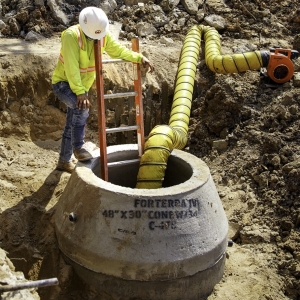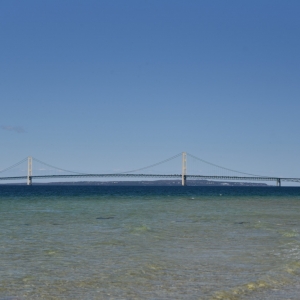Federal Water Tap, February 21: EPA Watchdog Will Investigate Agency’s Drinking Water Lead Response in Michigan City
The Rundown
- An EPA watchdog will investigate the agency’s response to drinking water lead contamination in Benton Harbor, Michigan.
- An EPA local government advisory committee submits recommendations to the agency for carrying out infrastructure investments.
- The CDC analyzes trends in the rising number of Legionnaires’ disease
- The EPA revises its methods for assessing the cost to communities of cleaning up sewage pollution.
- NOAA updates sea-level rise projections for U.S. coasts.
- Infrastructure bill funding will accelerate contaminated site cleanup in the Great Lakes
And lastly, EPA officials hone the details of the infrastructure bill implementation.
“We know that many vulnerable communities, including communities of color, have not received their fair share of water infrastructure funding and the consequences to those communities have been devastating.” — EPA Administrator Michael Regan, speaking at a meeting of the National Association of Counties. The agency is developing “implementation memos” for how infrastructure bill money distributed through the state revolving funds should be put to use. That guidance is expected to be finalized in the coming weeks.
By the Numbers
$1 Billion: Funding from the federal infrastructure bill that will be made available to restore contaminated sites in the Great Lakes basin. With the funds, the Biden administration aims to complete cleanups at 22 priority sites by 2030.
News Briefs
Financial Assessments for Clean Water Act Compliance
The U.S. Environmental Protection Agency is taking another swing at defining key concepts that govern Clean Water Act requirements for wastewater utilities.
In this case, it is the Financial Capability Assessment, which describes a community’s capacity to shoulder the costs of preventing sewage pollution of waterways. The assessment is not, as it is sometimes mistaken, intended to define “affordable” water for a household.
The goal, the EPA says, is to minimize financial impacts to low-income households while also ensuring that pollution-prevention investments are not unduly delayed.
As with so many policies these days, the proposal is the revision of a revision. The Biden administration is retooling a document initially put forward by Trump administration officials.
When the EPA orders communities to clean up sewer overflows, the agency sets a timetable for compliance, sometimes lasting decades. Current guidance dates to 1997 and focuses on financial impacts compared to median household income. That method has been criticized for neglecting the impact on a community’s poorest residents.
The proposed revision would consider the impact of rate increases at the 20th percentile of earners, offering two ways to calculate this. Or, it allows utilities to submit a more detailed financial analysis.
The revision also requires utilities to show that they have exhausted their options for providing assistance to low-income customers. And it limits most cleanup timelines to 20 years.
Studies and Reports
Legionnaires’ Disease Trends
A respiratory illness linked to bacteria that grow in building plumbing is exhibiting clear geographic, seasonal, and racial patterns, according to a CDC analysis of nearly three decades of data.
Summer and fall were always peak times for Legionnaires’ disease, the pneumonia-like illness caused by Legionella bacteria.
Those seasonal peaks are becoming more pronounced. From 1992 to 2002, some 58 percent of cases occurred between June and November. In the 15 years after 2003, when cases started to rise nationally, about 69 percent were recorded in those months.
The analysis also found regional and racial trends. More cases occur in the Midwest and Northeast, and Black Americans had a higher number of cases per capita than white.
What is driving these trends? Explanations were beyond the scope of this assessment, and the authors note that there are many possible causes. Temperature, precipitation, and humidity are possible factors in the geographic scope. For racial disparities, Black Americans often live in lower-quality and older housing and are in poorer health.
Legionella bacteria live in lakes and rivers, but they become a public health problem in buildings, where they multiply in plumbing and in heating and cooling systems. There are about 9,000 reported cases a year in the U.S.
In context: Risks Grow for Deadliest U.S. Drinking Water Hazard
Sea-Level Rise Update
Coastal areas in the United States should prepare for seas that are about a foot higher than today by 2050, according to NOAA’s updated seal-level rise projections.
There are significant regional differences. Water will rise a few inches higher in the Atlantic and Gulf coasts because the land is sinking at the same time. On the Pacific Coast, however, the land is rising due to less downward pressure from glaciers.
Infrastructure Act Implementation
The Local Government Advisory Committee, which provides the EPA with a ground-level view of the agency’s work, submitted recommendations for implementing the infrastructure bill that was signed into law last November.
The committee members are mostly mayors, council members, and city officials. They urged the EPA to consider climate change and environmental justice when it doles out infrastructure money. They also asked that smaller communities without large staff receive technical help to navigate the application process.
“As leaders of a diverse cross-section of local and state governments, we believe it is important that [infrastructure] funding both reaches communities quickly and is distributed in an inclusive, thoughtful manner that makes a transformative, equitable, and enduring difference in people’s daily lives,” the members wrote.
On the Radar
EPA Watchdog to Investigate Agency’s Response to Michigan City’s Lead Problem
The EPA Office of the Inspector General, a government watchdog, announced that it would investigate the agency’s response to drinking water lead contamination in Benton Harbor, Michigan.
The investigation will center on the agency’s national office and its Region 5 office, which includes the state of Michigan. The main question is whether the agency followed public health guidance it put in place in 2016 after the Flint lead crisis.
That guidance ordered agency staff to “elevate” issues that pose a threat to public health and are not being addressed by other government authorities.
Federal Water Tap is a weekly digest spotting trends in U.S. government water policy. To get more water news, follow Circle of Blue on Twitter and sign up for our newsletter.
Brett writes about agriculture, energy, infrastructure, and the politics and economics of water in the United States. He also writes the Federal Water Tap, Circle of Blue’s weekly digest of U.S. government water news. He is the winner of two Society of Environmental Journalists reporting awards, one of the top honors in American environmental journalism: first place for explanatory reporting for a series on septic system pollution in the United States(2016) and third place for beat reporting in a small market (2014). He received the Sierra Club’s Distinguished Service Award in 2018. Brett lives in Seattle, where he hikes the mountains and bakes pies. Contact Brett Walton







Leave a Reply
Want to join the discussion?Feel free to contribute!